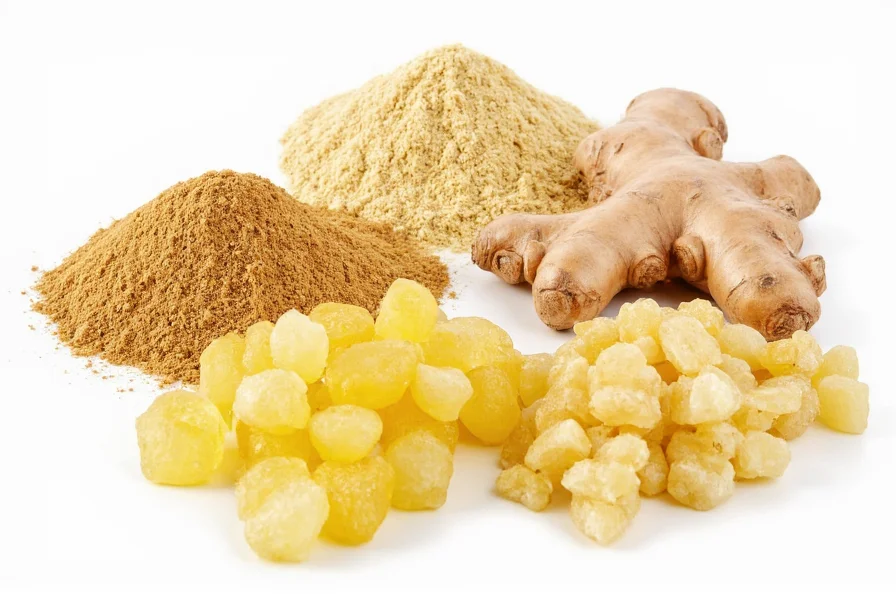One tablespoon (5g) of raw ginger contains approximately 5 calories, 1.3g carbohydrates, 0.1g protein, and provides 1% of the daily value for magnesium and potassium. Ginger's most valuable components are its bioactive compounds, particularly gingerols, which give it potent anti-inflammatory and antioxidant properties.
For those seeking precise ginger nutritional information per 100g, this versatile root offers a nutrient profile that makes it valuable beyond its distinctive flavor. Understanding the complete nutritional breakdown helps maximize its health benefits while incorporating it into your daily diet.
Comprehensive Ginger Nutrition Facts
Whether you're using fresh ginger root, ground ginger, or ginger supplements, knowing the exact nutritional composition helps you make informed dietary choices. The following table presents detailed raw ginger nutritional facts based on a standard 1-inch piece (approximately 17g), which represents a typical serving used in cooking and beverages:
| Nutrient | Amount per 17g (1-inch piece) | % Daily Value* |
|---|---|---|
| Calories | 11 | <1% |
| Total Carbohydrates | 2.4g | 1% |
| Dietary Fiber | 0.3g | 1% |
| Sugars | 0.5g | - |
| Protein | 0.2g | <1% |
| Total Fat | 0.1g | <1% |
| Vitamin C | 1.4mg | 2% |
| Magnesium | 4.8mg | 1% |
| Potassium | 51mg | 1% |
| Manganese | 0.1mg | 5% |
*Percent Daily Values based on a 2,000 calorie diet. Values may vary based on individual needs.

Understanding Ginger's Bioactive Compounds
While the basic nutritional profile appears modest, ginger's true value lies in its bioactive compounds. The most significant of these is gingerol, particularly 6-gingerol, which gives ginger its characteristic pungency and provides most of its health benefits. When ginger dries or cooks, gingerol transforms into shogaol, which has even more potent antioxidant properties.
These compounds explain why ginger nutritional value extends far beyond its basic vitamin and mineral content. Research shows these bioactives contribute to ginger's anti-inflammatory effects, which may help reduce muscle pain and soreness. A study published in the Journal of Pain found that daily ginger supplementation reduced exercise-induced muscle pain by 25%.
Health Benefits Supported by Ginger Nutrition Facts
The specific nutritional composition of ginger supports several evidence-based health benefits:
Digestive Health Support
Ginger's ability to accelerate gastric emptying makes it particularly valuable for digestive health. The nutritional information for ginger tea shows that even in liquid form, it retains significant amounts of gingerols that help reduce nausea and improve digestion. This explains its traditional use for morning sickness, with multiple studies confirming its effectiveness for pregnancy-related nausea without adverse effects.
Anti-Inflammatory Properties
The ginger root nutritional content includes compounds that inhibit inflammatory pathways in the body. For osteoarthritis patients, ginger extract has demonstrated pain reduction comparable to ibuprofen in some studies. The manganese content in ginger also contributes to antioxidant enzyme systems that combat oxidative stress.
Immune System Support
While not high in vitamin C compared to citrus fruits, the combination of antioxidants and anti-inflammatory compounds in ginger provides comprehensive immune support. The fresh ginger nutritional profile shows it contains zinc and selenium precursors that contribute to immune function, making it a valuable addition during cold and flu season.

Practical Applications of Ginger Nutrition Data
Understanding ground ginger nutritional information versus fresh ginger helps optimize its use in your diet. Dried ginger powder contains approximately double the concentration of gingerols by weight compared to fresh ginger, making it more potent for therapeutic uses but slightly lower in certain vitamins that degrade during drying.
For culinary applications, a general conversion guide:
- 1 inch fresh ginger = 1 tablespoon grated ginger = ¼ teaspoon ground ginger
- 1 tablespoon fresh grated ginger = approximately 4g
The ginger nutritional facts per tablespoon show that this common cooking measurement provides about 3 calories and measurable amounts of beneficial compounds. For therapeutic benefits, studies typically use doses equivalent to 1-3 grams of fresh ginger (about 2-6 teaspoons grated) daily.
Considerations for Optimal Ginger Consumption
While ginger offers numerous benefits, certain populations should monitor their intake. People taking blood-thinning medications should consult their healthcare provider before consuming large amounts of ginger, as its antiplatelet effects could potentially interact with these medications.
The complete nutritional breakdown of ginger shows it contains negligible amounts of common allergens, making it suitable for most dietary restrictions. However, those with gallstones should consult a physician before consuming therapeutic doses, as ginger may increase bile production.
For maximum nutrient retention, add fresh ginger toward the end of cooking rather than at the beginning. The heat-sensitive compounds begin degrading after prolonged exposure to high temperatures, reducing the medicinal value of ginger in cooked preparations.
Frequently Asked Questions About Ginger Nutrition
How does ginger nutritional content change when dried?
Drying ginger concentrates its bioactive compounds while reducing water-soluble vitamins. Per 100g, dried ginger contains approximately 335 calories, 18g dietary fiber, and double the concentration of gingerols compared to fresh ginger (which has about 80 calories per 100g). The vitamin C content decreases significantly during drying, but the antioxidant capacity actually increases due to the formation of shogaols.
What's the difference between ginger nutritional facts for fresh versus pickled ginger?
Pickled ginger contains additional sodium and sugar compared to fresh ginger. While a 1-inch piece of fresh ginger has negligible sodium, the same amount of pickled ginger may contain 100-200mg sodium and 1-2g added sugar. The gingerol content remains relatively stable during pickling, but the overall nutritional profile changes due to the added ingredients in the pickling solution.
How much ginger should I consume daily for health benefits?
Research suggests 1-3 grams of fresh ginger daily (approximately 1-2 inches of root) provides measurable health benefits without risk of side effects for most people. This equals about 8-24 calories from ginger itself. For specific conditions like nausea, studies have used doses as low as 1g, while anti-inflammatory effects may require closer to 2-3g daily. Always consult with a healthcare provider before using ginger therapeutically if you have underlying health conditions.
Does ginger contain significant protein or fiber?
While not a primary source, ginger does contribute modest amounts of both. One ounce (28g) of raw ginger contains approximately 0.9g of dietary fiber (3% of daily value) and 0.6g of protein. The fiber in ginger primarily consists of insoluble fiber, which supports digestive health. When consumed regularly as part of a balanced diet, these small contributions can add up to meaningful nutritional benefits, especially considering ginger's low calorie count.











 浙公网安备
33010002000092号
浙公网安备
33010002000092号 浙B2-20120091-4
浙B2-20120091-4